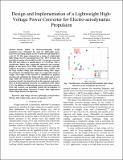Design and implementation of a lightweight high-voltage power converter for electro-aerodynamic propulsion
Author(s)
He, Yiou; Woolston, Mark R.; Perreault, David J
DownloadAccepted version (1.260Mb)
Terms of use
Metadata
Show full item recordAbstract
Recent studies in electro-Aerodynamic (EAD) propulsion have stimulated the need for lightweight power converters providing outputs at tens of kilovolts and hundreds of watts [1] [2]. This paper demonstrates a design of a lightweight high-voltage converter operating from a 160-200 V dc input and providing dc output of up to 600 W at 40 kV. It operates at around 500 kHz and achieves a specific power of 1.2 kW/kg. This is considerably lighter than comparable industrial and academic designs at this power level. High voltage converters generally comprise an inverter, a step-up transformer and a rectifier, with the large needed voltage gain distributed among these stages. Several means of realizing these stages are compared in terms of weight. The weight of the converter is minimized by properly selecting and optimizing the design and the voltage gain of each stage within the constraints of device limitations and losses. A prototype circuit is developed based on this approach and used to drive an EAD-propulsion system for an unmanned aerial vehicle (UAV). In addition to addressing the power conversion needs for EAD, this research can potentially benefit the development of lightweight high-voltage converters in many other applications where weight and size are important.
Date issued
2017-08Department
Massachusetts Institute of Technology. Department of Electrical Engineering and Computer Science; Lincoln LaboratoryJournal
2017 IEEE 18th Workshop on Control and Modeling for Power Electronics (COMPEL)
Publisher
Institute of Electrical and Electronics Engineers (IEEE)
Citation
He, Yiou et al. "Design and implementation of a lightweight high-voltage power converter for electro-aerodynamic propulsion." 2017 IEEE 18th Workshop on Control and Modeling for Power Electronics (COMPEL), July 2017, Stanford, California, USA, Institute of Electrical and Electronics Engineers (IEEE), August 2017 © 2017 IEEE
Version: Author's final manuscript
ISBN
9781509053261